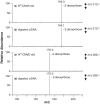Synthesis and characterization of oligodeoxyribonucleotides containing a site-specifically incorporated N6-carboxymethyl-2'-deoxyadenosine or N4-carboxymethyl-2'-deoxycytidine
- PMID: 20507914
- PMCID: PMC2965219
- DOI: 10.1093/nar/gkq458
Synthesis and characterization of oligodeoxyribonucleotides containing a site-specifically incorporated N6-carboxymethyl-2'-deoxyadenosine or N4-carboxymethyl-2'-deoxycytidine
Abstract
Humans are exposed to both endogenous and exogenous N-nitroso compounds (NOCs), and many NOCs can be metabolically activated to generate a highly reactive species, diazoacetate, which is capable of inducing carboxymethylation of nucleobases in DNA. Here we report, for the first time, the chemical syntheses of authentic N(6)-carboxymethyl-2'-deoxyadenosine (N(6)-CMdA) and N(4)-carboxymethyl-2'-deoxycytidine (N(4)-CMdC), liquid chromatography-ESI tandem MS confirmation of their formation in calf thymus DNA upon diazoacetate exposure, and the preparation of oligodeoxyribonucleotides containing a site-specifically incorporated N(6)-CMdA or N(4)-CMdC. Additionally, thermodynamic studies showed that the substitutions of a dA with N(6)-CMdA and dC with N(4)-CMdC in a 12-mer duplex increased Gibbs free energy for duplex formation at 25°C by 5.3 and 6.8 kcal/mol, respectively. Moreover, primer extension assay revealed that N(4)-CMdC was a stronger blockade to Klenow fragment-mediated primer extension than N(6)-CMdA. The polymerase displayed substantial frequency of misincorporation of dAMP opposite N(6)-CMdA and, to a lesser extent, misinsertion of dAMP and dTMP opposite N(4)-CMdC. The formation and the mutagenic potential of N(6)-CMdA and N(4)-CMdC suggest that these lesions may bear important implications in the etiology of NOC-induced tumor development.
Figures






Similar articles
-
In vitro replication studies of carboxymethylated DNA lesions with Saccharomyces cerevisiae polymerase η.Biochemistry. 2011 Sep 6;50(35):7666-73. doi: 10.1021/bi2007417. Epub 2011 Aug 11. Biochemistry. 2011. PMID: 21809836 Free PMC article.
-
Large scale synthesis of p-benzoquinone-2'-deoxycytidine and p-benzoquinone-2'-deoxyadenosine adducts and their site-specific incorporation into DNA oligonucleotides.Chem Res Toxicol. 1995 Sep;8(6):865-74. doi: 10.1021/tx00048a007. Chem Res Toxicol. 1995. PMID: 7492736
-
Replication studies of carboxymethylated DNA lesions in human cells.Nucleic Acids Res. 2017 Jul 7;45(12):7276-7284. doi: 10.1093/nar/gkx442. Nucleic Acids Res. 2017. PMID: 28531304 Free PMC article.
-
Chemical synthesis of oligodeoxyribonucleotides containing N3- and O4-carboxymethylthymidine and their formation in DNA.Nucleic Acids Res. 2009 Feb;37(2):336-45. doi: 10.1093/nar/gkn946. Epub 2008 Nov 28. Nucleic Acids Res. 2009. PMID: 19042973 Free PMC article.
-
Formation of Carboxymethyl-Phosphotriester Adducts in DNA.Chem Res Toxicol. 2025 May 19;38(5):892-899. doi: 10.1021/acs.chemrestox.4c00547. Epub 2025 Apr 16. Chem Res Toxicol. 2025. PMID: 40235319
Cited by
-
Transcriptional inhibition and mutagenesis induced by N-nitroso compound-derived carboxymethylated thymidine adducts in DNA.Nucleic Acids Res. 2015 Jan;43(2):1012-8. doi: 10.1093/nar/gku1391. Epub 2015 Jan 8. Nucleic Acids Res. 2015. PMID: 25572317 Free PMC article.
-
DNA replication studies of N-nitroso compound-induced O6-alkyl-2'-deoxyguanosine lesions in Escherichia coli.J Biol Chem. 2019 Mar 15;294(11):3899-3908. doi: 10.1074/jbc.RA118.007358. Epub 2019 Jan 17. J Biol Chem. 2019. PMID: 30655287 Free PMC article.
-
Metabolic Activation and DNA Interactions of Carcinogenic N-Nitrosamines to Which Humans Are Commonly Exposed.Int J Mol Sci. 2022 Apr 20;23(9):4559. doi: 10.3390/ijms23094559. Int J Mol Sci. 2022. PMID: 35562949 Free PMC article. Review.
-
In vitro replication studies of carboxymethylated DNA lesions with Saccharomyces cerevisiae polymerase η.Biochemistry. 2011 Sep 6;50(35):7666-73. doi: 10.1021/bi2007417. Epub 2011 Aug 11. Biochemistry. 2011. PMID: 21809836 Free PMC article.
-
Roles of Aag, Alkbh2, and Alkbh3 in the Repair of Carboxymethylated and Ethylated Thymidine Lesions.ACS Chem Biol. 2016 May 20;11(5):1332-8. doi: 10.1021/acschembio.6b00085. Epub 2016 Mar 4. ACS Chem Biol. 2016. PMID: 26930515 Free PMC article.
References
-
- Lindahl T. Instability and decay of the primary structure of DNA. Nature. 1993;362:709–715. - PubMed
-
- Correa P. Human gastric carcinogenesis: a multistep and multifactorial process - 1st American Cancer Society award lecture on cancer epidemiology and prevention. Cancer Res. 1992;52:6735–6740. - PubMed
-
- Tricker AR. N-nitroso compounds and man: sources of exposure, endogenous formation and occurrence in body fluids. Eur. J. Cancer Prev. 1997;6:226–268. - PubMed
-
- Risch HA. Etiology of pancreatic cancer, with a hypothesis concerning the role of N-nitroso compounds and excess gastric acidity. J. Natl Cancer Inst. 2003;95:948–960. - PubMed
-
- Hecht SS. DNA adduct formation from tobacco-specific N-nitrosamines. Mutat. Res. 1999;424:127–142. - PubMed
Publication types
MeSH terms
Substances
Grants and funding
LinkOut - more resources
Full Text Sources
Other Literature Sources
Miscellaneous

